
KNOWLE LOCAL HISTORY SOCIETY

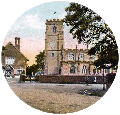

Knowle Picture Playhouse
Now Johnsons Cars
(No Connection to F. J. Johnson & Son)
Film shows in Knowle first started at the Wilson Arms in 1919/20. The licence was held by the landlord, Mrs. Tansley. There were four shows each week: Thursday and Friday and Saturday evenings, plus an afternoon show on Saturdays. Prices were 2d, 3d and 6d (6d = 2½p). The films were silent, with piano or violin accompaniment, and everyone sat on benches. Mrs. Tansley eventually transferred the licence to Jack Chamberlain, who built Knowle Picture Playhouse on Station Road in 1924, where the garage is today.
Jack Chamberlain had been apprenticed to Vickers and was generally regarded as very clever and very experienced with engines. He brought the stone for the building from Kenilworth on his steam engine; the cinema generated its own electricity with a diesel generator around the back, where Jack Chamberlain lived in a caravan he had bought from Bronko Bill c. 1926. He also had a yacht moored at Knowle locks, where he also lived at times. One night before the war tragedy struck: he was killed on his way to his boat in his car when it ran down the embankment. He was quite young.
A small orchestra accompanied the silent films and names recalled included Mrs. Thornton, Jack Yorke, Bonar Owen, Horace Sanders, and Bill and Jack Fletcher who played drums and provided the sound effects. Jack's contributions were recalled a "guns and bombs going off everywhere”. Those were happy days. Ron Court recalled the first films:
I can remember the first film they had there, it was Jackie Coogan in 'The Kid'. But because of the huge number of available artistes that had been thrown out of work, they had to have a spell of half an hour in between … where you had artists come on. And one day descended on Knowle two people. His name was Haji Baba and Sonia. They were mind readers, and he used to wear a turban with a great big red ruby on. He used to come on the stage, and Sonia would go “What have I got my hand on now?” and he'd say “A fountain pen”. “What colour is it?”...”Black”. And they were feted all in Knowle because they used to put on acts in the pubs as well, and no one quite knew how they ..... But I understand that they ran up debts everywhere, they stayed at the Swan … I don't know whether this is true. And they never paid ... when they used to buy a round of drinks they put it on the slate you know. I know they had grocery bills … my father [owner of Court’s Grocery Stores], he was taken in with them. And suddenly they disappeared ... some wag in the Swan said the next night “I saw him about 2 o'clock this morning on his magic carpet!” Haji Baba and Sonia, I often wonder what happened to them, I used to watch them spellbound.
Knowle Picture Playhouse was one of the first houses in England to show ‘talkies’.
It was a sensation when it opened and brought people flocking in from miles away.
In the 1930s seats in the first six rows, which were benches, cost 3d. The rest
of the stalls were 6d., 9d. and 1/3d. Upstairs, where seats could be reserved, the
price was 1/6d. Many regulars reserved the same seats every week, and woe betides
anybody else who tried to use them. The balcony was certainly the best vantage point;
the only problem being that the roof was made of corrugated iron, and if it rained,
one couldn't hear a thing. The cinema was a focal point in the village enjoyed by
old and young alike and a good thing for the village, where young people met and
the boys courted their young ladies. Children usually waited for an opportune moment
to slip in the side door -
The cinema thrived until competition arrived with the advent of television, particularly when many sets were bought for the coronation of Her Majesty the Queen in 1953. It remained a cinema until 1955, when it was sold and became a garage. Remnants of the old building remain.
An early film.
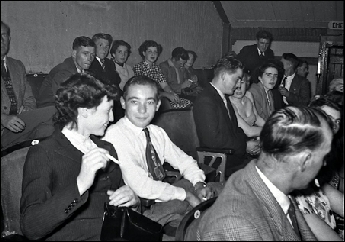
An audience in 1954
Looking towards the balcony, 1954
Sold. 1955.
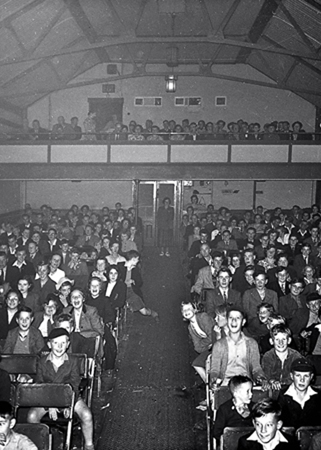
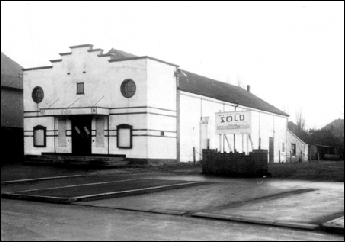
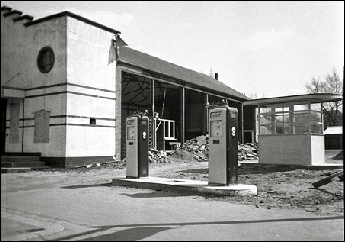
Demolition of the side, and petrol pumps going in.
| The Church |
| The Guild House |
| The Red Lion |
| Paterson Court (Old School) |
| Milverton Farm (Petrol Station) |
| Kixley Lane Cottages |
| Far End & The Cottage |
| Milverton House & Milverton Crescent |
| Berrow Cottage Homes |
| Wilsons Row |
| Knowle Library (Chester House) |
| Greswolde Arms Hotel |
| Grimshaw Hall 1560 - 1765 |
| Grimshaw Hall After 1765 |
| Malthouse Row (Nos 19 to 25) |
| Eastcote Ford |
| The Wilson Arms |
| Artillery Cottages |
| Knowle Lodge (Knowle Surgery) |
| Jobs Close |
| The Olde House |
| Knowle Picture Playhouse (Johnsons Cars) |